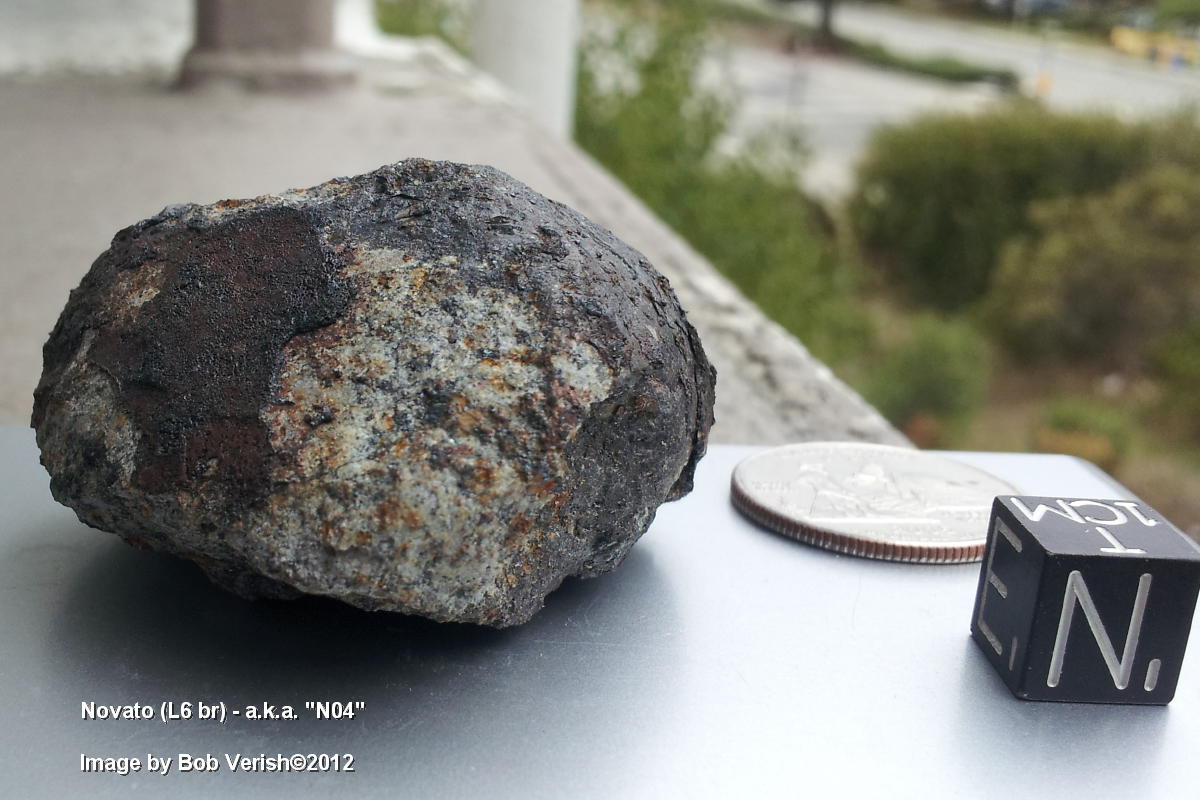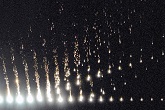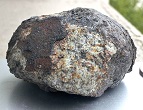![]()
Novato - Collision History Revealed in California Rock

Novato (N04) - 4th stone recovered from the 4th California fall.
The meteorite that fell onto the roof of Lisa Webber's house in Novato, California, on Oct. 17, 2012, has revealed a detailed picture of its origin and tumultuous journey through space and Earth's atmosphere. Peter Jenniskens led an international consortium of fifty researchers that studied the recovered meteorite and published their findings in the August issue of the journal Meteoritics and Planetary Science.
Peter Jenniskens, who is a meteor astronomer and is the principal investigator for the consortium study, works for the SETI Institute, Mountain View, California at NASA's Ames Research Center in Moffett Field, California. He recently announced, "Our investigation has revealed a long history that dates to when the moon formed from the Earth after a giant impact."
The fall of the Novato meteorite was monitored by Peter Jenniskens' astronomical surveillance network, CAMS (Cameras for Allsky Meteor Surveillance), which gave researchers something of a guess about where the object may have came down. The early reports that it was somewhere near Martinez, were unfounded. But days later, after hearing on the news that a meteorite fell (and remembering hearing a noise on the roof that same night), Novato resident Lisa Webber reported that she had recovered a rock that must have fallen on her roof. That stone turned out to be the first of the (currently 6) meteorite fragments to be recovered (and the reason these objects are now called the Novato meteorite).
Over the next several weeks, five more stones, most of them are just a couple of centimeters across, turned up within a few kilometers of Lisa Webber’s home - - a story that is retold on the CAMS website. These rocks revealed the evidence that allowed the scientists to piece together what they call "the space rock’s tumultuous journey.”
Qing-zhu Yin, professor in the Department of Earth and Planetary Sciences at the University of California - Davis, said, "We determined that the meteorite likely got its black appearance from massive impact shocks causing a collisional resetting event 4.472 billion years ago, roughly 64-126 million years after the formation of the solar system," and added, "We now suspect that the moon-forming impact may have scattered debris all over the inner solar system and hit the parent body of the Novato meteorite."
Jenniskens successfully measured the Novato approach orbit and confirmed that the Gefion asteroid family in the middle of the main asteroid belt can be the source of the meteorites.
Kees Welten, a cosmochemist at UC Berkeley, said, "Novato broke from one of the Gefion family asteroids nine million years ago."
Kunihiko Nishiizumi, a cosmochemist also of UC Berkeley, added, "But the rock that was to become Novato, may have been buried in a larger object until about one million years ago."
Derek Sears, a meteoriticist working for the Bay Area Environmental Research Institute in Sonoma, California, at Ames said, "We can tell the rock was heated, but the cause of the heating is unclear. It seems that Novato was hit again."
The researchers have collaborated to produce this scenario of violent episodes dating back nearly 4.5 billion years and ending on Oct. 17, 2012, when the bolide broke up and fell on and around the Marin County suburb of Novato:
Daniel Glavin at NASA’s Goddard Space Flight Center in Greenbelt, Maryland, led a team to search the Novato meteorites for amino acids – molecules present in and essential for life on Earth – and detected some unusual non-protein amino acids that are now very rare on Earth but indigenous to the Novato meteorite.
Researchers were surprised to find that all these impacts did not completely destroy the organic compounds in this meteorite. Qinghao Wu and Richard Zare of Stanford University in California measured a rich array of polycyclic aromatic hydrocarbon compounds – complex, carbon-rich molecules that are both widespread and abundant throughout the universe.
Jenniskens says that, "The quick recovery of the Novato meteorites made these studies possible."
The research was supported by the NASA Near Earth Object Observation, Planetary Astronomy and Cosmochemistry programs, and the Swiss National Science Foundation.
The following is the Abstract and the Table of Contents as published in:
[Copyright Clearance Center - License Number: 3462651289692 ]
The fragmentation of the Novato meteorite on Oct. 17, 2012, as depicted
in a horizontally mirrored image to show the progression of the event (from left to right).
(Credit: Robert P. Moreno Jr., Jim Albers and Peter Jenniskens/NASA-SETI)
(The Novato Meteorite Consortium) :
Peter JENNISKENS (1,2),
Alan E. RUBIN (3, Qing-Zhu YIN4, Derek W. G. SEARS (2,5,
Scott A. SANDFORD (2), Michael E. ZOLENSKY (6),
Alexander N. KROT (7), Leigh BLAIR (1),
Darci KANE (8), Jason UTAS (9),
Robert VERISH (10), Jon M. FRIEDRICH (11,12), Josh WIMPENNY (4),
Gary R. EPPICH (13), Karen ZIEGLER (14),
Kenneth L. VEROSUB (4), Douglas J. ROWLAND (15),
Jim ALBERS (1), Peter S. GURAL (1), Bryant
GRIGSBY (1), Marc D. FRIES (6), Robert MATSON (16),
Malcolm JOHNSTON (17), Elizabeth SILBER (18),
Peter BROWN (18), Akane YAMAKAWA (4),
Matthew E. SANBORN (4), Matthias LAUBENSTEIN (19),
Kees C. WELTEN (20), Kunihiko
NISHIIZUMI (20),
Matthias M. M. MEIER (21,22),
Henner BUSEMANN (23), Patricia CLAY (23), Marc W. CAFFEE (24),
Phillipe SCHMITT-KOPPLIN (25,26), Norbert HERTKORN (25), Daniel P. GLAVIN (27),
Michael P. CALLAHAN (27), Jason P. DWORKIN (27),
Qinghao WU (28), Richard N. ZARE (28),
Monica GRADY (29), Sasha VERCHOVSKY (29), Vacheslav EMEL’YANENKO (30),
Sergey NAROENKOV (30), David L. CLARK (18),
Beverly GIRTEN (2), Peter S. WORDEN (2)
(The Novato Meteorite Consortium) :
1 ) SETI Institute, Carl Sagan Center,
Mountain View, California 94043, USA
2 ) NASA Ames Research Center, Moffett
Field, California 94035, USA
3 ) Institute of Geophysics and Planetary
Physics, UCLA, Los Angeles, California 90095–1567, USA
4 ) Department of Earth and Planetary
Sciences, University of California at Davis, Davis, California 95616–8605, USA
5 ) BAER Institute, Mountain View,
California 94043, USA
6 ) Astromaterials Research and Exploration
Science, NASA Johnson Space Center, Houston, Texas 77801, USA
7 ) Hawai‘i Institute of Geophysics and
Planetology, University of Hawai‘i at Manoa,
Honolulu, Hawai‘i 96822, USA
8 ) Buck Institute, Novato, California
94945, USA
9 ) Institute of Geophysics and Planetary
Physics, UCLA, Los Angeles, California 90095–1567, USA
10) Meteorite Recovery Laboratory, P.O. Box
463084, Escondido, California 92046, USA
11) Department of Chemistry, Fordham
University, Bronx, New York 10458, USA
12) Department of Earth and Planetary
Sciences, American Museum of Natural History, New York, New York 10024, USA
13) Lawrence Livermore National Laboratory,
Glenn Seaborg Institute, Livermore, California 94550, USA
14) Institute of Meteoritics, University of
New Mexico, Albuquerque, New Mexico 87131–0001, USA
15) Center for Molecular and Genomic
Imaging, University of California at Davis, Davis, California 95616, USA
16) S.A.I.C., San Diego, California
92121, USA
17) US Geological Survey, Menlo Park,
California 94025, USA
18) Department of Physics & Astronomy,
University of Western Ontario, London, Ontario N6A 3K7, Canada
19) Lab. Naz. del Gran Sasso,
Inst. Naz. di Fiscia Nucleare, I-67010 Assergi (AQ), Italy
20) Space Sciences Laboratory, University
of California, Berkeley, California 94720, USA
21) Department of Earth Sciences, ETH Z€urich,
CH-8092 Z€urich,
Switzerland
22) Department of Geology, Lund University,
SE-22362 Lund, Sweden
23) School of Earth, Atmospheric and
Environmental Sciences (SEAES), University of Manchester, Manchester M13 9PL,
UK
24) Department of Physics, Purdue
University, West Lafayette, Indiana 47907, USA
25) B.G.C., Helmholtz Zentrum M€unchen, D-85764 M€unchen, Germany
26) A.L.C., Technische
Universit€at
M€unchen-TUM,
D-85354 Freising, Germany
27) Solar System Exploration Division, NASA
Goddard Space Flight Center, Greenbelt, Maryland 20771, USA
28) Department of Chemistry, Stanford
University, Stanford, California 94305–5080, USA
29) Planetary and Space Science Research
Institute, Open University, Milton Keynes MK7 6AA, UK
30) Institute of Astronomy of the Russian Academy of Sciences (INASAN),
Moscow 119017, Russia
Abstract – The
Novato L6 chondrite fragmental breccia fell in
California on 17 October 2012,
and
was recovered after the Cameras for Allsky Meteor
Surveillance (CAMS) project
determined the meteor’s trajectory between 95 and 46 km
altitude. The final fragmentation
from
42 to 22 km altitude was exceptionally well documented by digital photographs.
The first
sample was recovered before rain hit the area. First results from a consortium
study of
the
meteorite’s characterization, cosmogenic and
radiogenic nuclides, origin, and conditions of
the fall are presented. Some meteorites did not retain fusion crust and show
evidence of spallation.
Before entry, the meteoroid was 35 ± 5 cm in
diameter (mass 80 ± 35 kg) with a
cosmic-ray exposure age of 9 ± 1 Ma, if it had a one-stage exposure history.
A two-stage exposure
history is more likely, with lower shielding in the last few Ma.
Thermoluminescence data suggest a collision event within the
last ~0.1 Ma.
Novato probably
belonged to the class of shocked L chondrites that
have a common shock
age of 470
Ma, based on the U,Th-He age
of 420 ± 220 Ma. The measured orbits of Novato,
Jesenice, and Innisfree are
consistent with a proposed origin of these shocked L chondrites
in
the Gefion asteroid family, perhaps directly via the
5:2 mean-motion resonance with Jupiter.
Novato experienced a stronger compaction than did other L6 chondrites
of shock-stage S4
Despite this, a freshly broken surface shows a wide range of organic compounds.
Source: Meteoritics
& Planetary Science 1–38 (2014)
doi:
10.1111/maps.12323
The fragmentation of the Novato meteorite on Oct. 17, 2012, as depicted
in a horizontally mirrored image to show the progression of the event (from left to right).
(Robert P. Moreno Jr., Jim Albers and Peter Jenniskens/NASA-SETI)
INTRODUCTION
MATERIALS AND METHODS
METEORITE PROPERTIES AND CLASSIFICATION
Mechanical
Properties and Magnetic Susceptibility
Petrography and
Mineralogy
Bulk Chemical
Composition
Oxygen and
Chromium Isotopes
CONDITIONS OF THE FALL AND PRE-ATMOSPHERIC ORBIT
Trajectory and
Pre-Atmospheric Orbit
Light Curve and
Initial Mass
Dark Flight and
Source Energy
Fragmentation
Ablation
Spallation
THE METEOROID IN SPACE
Meteoroid
Diameter
Cosmic-Ray
Exposure Age
Thermal
Resetting Events
More Recent
Heating Events
Collisional
Compaction
ORGANIC MATTER
Methanol Soluble
Organics
Amino Acids
Polyaromatic Hydrocarbons
Macromolecular
Carbon and Carbon and Nitrogen Isotopes
DISCUSSION
Possible Source
Region in the Asteroid Main Belt
Pre-Atmospheric
Detection
CONCLUSIONS
Acknowledgments
Editorial Handling
REFERENCES
Fig. 1. All
recovered Novato meteorites, with sample identification chart for Novato N01
(scale in mm).
Fig. 2.
Photographic images of cut Novato faces showing the brecciated chondritic texture...
Fig. 3. X-ray
CT imagery of Novato N05 and N06...
Fig. 4. Backscattering electron (BSE) images of Novato N06.
Fig. 5. Mean
CI-normalized abundances of lithophiles, siderophiles, and moderately volatile elements in Novato...
Fig. 6. CI chondrite normalized rare earth element pattern of
fragments of Novato N01, N05, and N06.
Fig. 7.
Combined elemental maps of Novato N06...
Fig. 8.
Combined elemental maps of Novato N06...
Fig. 9. Diagrams,
showing Novato isotope data together with H, L, and LL chondrites...
Fig. 10.
Cameras for Allsky Meteor Surveillance detections of
the November 17 fireball...
Fig. 11.
Trajectory solutions derived from different combinations of cameras ... and the
station locations...
Fig. 12.
Observed minus calculated values for azimuth and elevation of the meteor in all
video frames...
Fig. 13. Novato fireball visual brightness as seen from a distance of 100
km, and the approximate deceleration profile.
Fig. 14.
Doppler weather radar returns (KMUX 2:39:44 UT)...
Fig. 15.
Fragmentation and relative deceleration at the end of the trajectory in a
compilation of digital photographs...
Fig. 16. A, B)
Details of the fusion crust of N01, and C, D) Evidence for spallation in Novato
N03...
Fig. 17. Stereoplot of
major axis orientations of all individual metal grains in two different stones
of the Novato fall.
Fig. 18. Degree
of compaction...
Fig. 19. Ion
cyclotron resonance Fourier transform mass
spectrometry (ICRFT/MS).
Fig. 20.
One-dimensional 1H NMR spectra (800 MHz, CD3OD)...
Fig. 21. L2MS spectrum of Novato N01-1b.
Fig. 22. Data
from stepped combustion-gas source-mass spectrometry of light and dark lithologies from Novato 01-1e.
Table 1. Overview of recovered meteorites.
Table 2.
Summary of XRF-derived major elemental composition data for Novato N06
(slab)...
Table 3.
Preliminary mean CI (Orgueil) weight normalized
compositions of lithophiles, siderophiles,
etc. in Novato...
Table 4.
Abundances of major, minor, and trace elements in the
Novato L6 chondrite.
Table 5a.
Summary of oxygen isotope values for Novato.
Table 5b.
Summary of chromium isotope values for Novato,
compared with mean values from other meteorites.
Table 6a. Novato
trajectory from all Cameras for Allsky Meteor
Surveillance (CAMS)...
Table 6b. Overview of Novato orbit determinations (Equinox J2000).
Table 7.
Summary of the infrasound signal measurements...
Table 8a. Massic activities of cosmogenic
radionuclides ... measured by nondestructive gamma-ray spectroscopy.
Table 8b.
Concentrations of U, Th, and K ... measured by
nondestructive gamma-ray spectroscopy.
Table 9a. Noble gas (He, Ne, Ar) analysis of two samples,
22.8 mg of N01-2b-7 and 47.8 mg of N01-2b-14.
Table 9b.
Krypton abundances and isotope ratios (84Kr = 100) in Novato samples.
Table 9c. Xenon
abundances and isotope ratios (132Xe = 100) in Novato samples.
Table 10. Thermoluminescence data for the light and dark lithologies of the Novato meteorite...
Table 11.
Summary of 1H NMR section integrals for light and dark lithology methanolic extracts.
Table 12.
Summary of the amino acid analysis from methanol spray sampling for light and
dark lithologies of Novato N01-2a.
Table 13. Carbon
and nitrogen stepped combustion data from Novato N01-1e.
Table 14a.
Overview of other known L chondrite falls ...
Table 14b. The
calculated dynamical lifetime for meteoroids...
This may be the most thoroughly studied L6-chondrite fall.
In closing, I would like to invite anyone who has an interest, and is in the San Diego area, to this years installment of The Meteorite & Tektite Party which has had a long tradition here in Southern California. It will be held on September 14th. It was a lot of fun last year (where the main entertainment became an impromptu show & tell of meteorites), and I'm looking forward to seeing everyones latest acquistions this year.
This small fete will, again, be held at the same venue as last year, as well as, where my 65th Birthday Party was held two years ago, and is where I got the idea to resurrect the old Annual Tektite Party (hosted by Paul Harris and Jim Tobin) that I used to attend 10 years ago in Torrance, California.
This year the "Meteorite & Tektite Party", again, is an open event to anyone that will be "in the San Diego area" or is willing to travel down the Interstates to San Marcos, California. The credit for actually organizing and running this event goes to my better-half, Monika Waiblinger. She suggested that we have another Party on her Facebook Group called the "California Meteorite Club". We have confirmation from people who live in Silicon Valley and Los Angeles that they will be attending the Party this year.
Moni will be setting up tables for meteorite displays, since it seemed that everyone brought a meteorite with them last year. There's a rumor that there will be a birthday cake this year for Boumdeid (2011). There will be some discussion about having a "slab exchange" (trade specimens), or a "silent auction", or even giving talks and presentations at next years Meteorite Party.
Hope that you get this invitation in time and can make it. See you there.
 -- Meteoritics & Planetary Science | Volume 49, Issue 8, pages 1388–1425, August 2014 --
-- Meteoritics & Planetary Science | Volume 49, Issue 8, pages 1388–1425, August 2014 --
"Fall, recovery, and characterization of the Novato L6 chondrite breccia" --
Meteoritics & Planetary Science 1–38 (2014) doi: 10.1111/maps.12323
 -- NASA Press Release - Ames Research Lab:
-- NASA Press Release - Ames Research Lab:
"NASA, Partners Reveal California Meteorite's Rough and Tumble Journey" --
Published online 15 August 2014
 -- NATURE | RESEARCH HIGHLIGHTS in Astronomy:
-- NATURE | RESEARCH HIGHLIGHTS in Astronomy:
"Collision history written in rock " Nature 512, 350 (28 August 2014) doi:10.1038/512350c
Published online 27 August 2014
For a "copy" of the published paper | click on REPRINT on the "Nature - International Weekly Journal of Science" website.
Search the Meteoritical Bulletin Database for California meteorite fall with "name" : Novato
"Bob's Findings" -- An Article In Meteorite-Times Magazine by Robert Verish (November 1, 2012) --
"The Recovery of the "Novato" Meteorite that Fell on 2012 October 18, 02:44 UT (Oct. 17, 19:44 PDT)" --
A compilation of field reports - images - news items regarding this California meteorite fall.
My previous articles can be found *HERE*
For more information, please contact me by email:
Bolide*chaser
